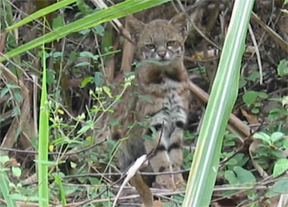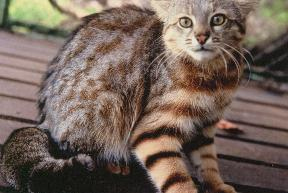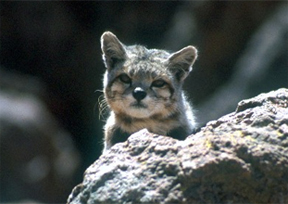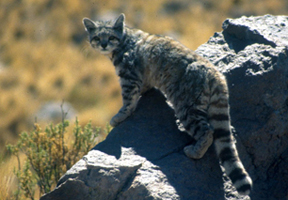Mystery cat discovered in Ecuador is likely a pampas cat according to expert
Mystery cat discovered in Ecuador is likely a pampas cat according to expert
Jeremy Hance, mongabay
October 28, 2008
“Mystery feline” really isn’t a mystery but conservation of its habitat is important nonetheless.
Two years ago a mysterious wild cat was spotted in Peru. The cat was photographed recently by Aldo Sornoza of Fundacion Jocotoco (FJ) in Ecuador's Jorupe Reserve, close to the Peruvian border.
According to an article from the World Land Trust, researchers in the area are debating whether the cat is new species or the rare Andean cat. Jim Sanderson, one of the world's foremost experts on small cats, believes it is neither.
After studying the picture Sanderson spoke to Mongabay.com. "The cat shown in the photograph…is the lovely Pampas cat found in this region. Pampas cats show a variety of morphs depending upon where they occur. In Brazil they are all brown for instance and in the Andes they are spotted, have a pink nose, and striking black lines across the forelegs."
 Photo by Aldo Sornoza of Fundacion Jocotoco and The World Land Trust
Conservation groups have been known to use the apparent discovery of a new species to draw attention to their initiatives. For example, in 2005 WWF claimed to have captured on film a “new species of carnivore” in Borneo around the time that the group was pushing its “Heart of Borneo” conservation project. Mammal experts quickly dismissed the claim — the animal was clearly a flying squirrel moving on the forest floor — but WWF capitalized on the PR stunt and the Heart of Borneo initiative eventually won approval by the governments of Malaysia, Indonesia, and Brunei. |
Sanderson sent Mongabay a picture of the pampas cat and told us to pay particular attention to the pampas cat's forelegs, which are similar to cat in the photograph.
Sanderson is skeptical that it is an Andean cat, because "they are not known to occur in Ecuador and in fact the geographic distribution includes only the southern portion of the Andes in Peru." However, several subspecies of the pampas cat have been documented in Ecuador.
The pampas cat is considered threatened due to habitat loss. Once native to the pampas in Argentina, from which it gets its name, a survey in 2002 found little evidence that the cat still inhabited the region.
The Jorupe Reserve, where the cat was photographed, is a dry tropical forest. Currently the reserve is 3,000 acres, but the World Land Trust and its partner FJ hope to double the reserve's size. The reserve was created to protect 59 species of birds found only in this region, including the endangered gray-cheeked parakeet. Evidence of the threatened pampas cat makes this reserve even more important.
Related articles
Often overlooked, small wild cats are important and in trouble: An interview with small cat specialist Dr. Jim Sanderson August 5, 2008
While often over-shadowed by their larger and better-known relatives like lions, tigers, leopards, and jaguars, small cats are important indicators of the health of an ecosystem, says a leading small cat expert who uses camera traps extensively to document and monitor mammals in the wild.
‘Snow leopard’ of the Andes is one of the world’s most endangered cats: An interview with Mauro Lucherini of the Andean Cat Alliance September 29, 2008
One of the world’s rarest cats is also one of its least known. The Andean mountain cat, sometimes called the “snow leopard” of the Andes, is an elusive species found only at high elevations of the Andean region in Argentina, Bolivia, Chile and Peru. Little is known about its ecology and behavior. While the species is known to be rare, no one knows how many individuals survive in the wild. Mauro Lucherini and his colleagues at the Andean Cat Alliance (AGA) are working to change this.
















